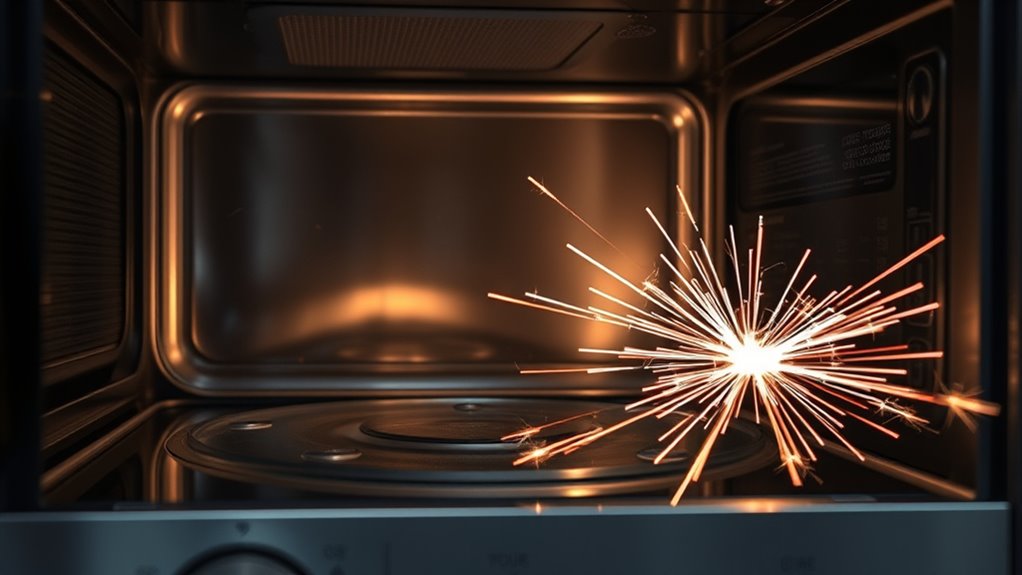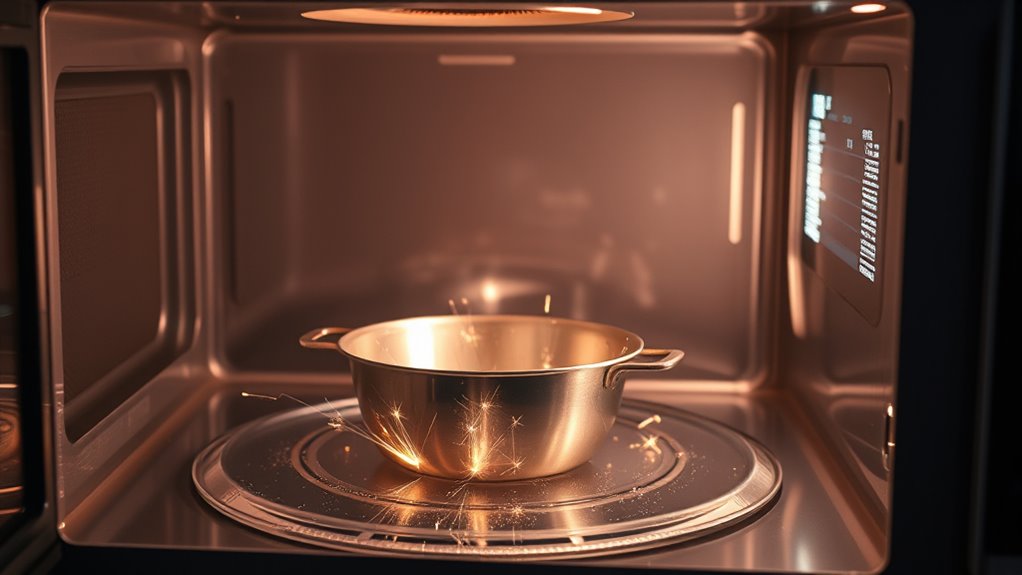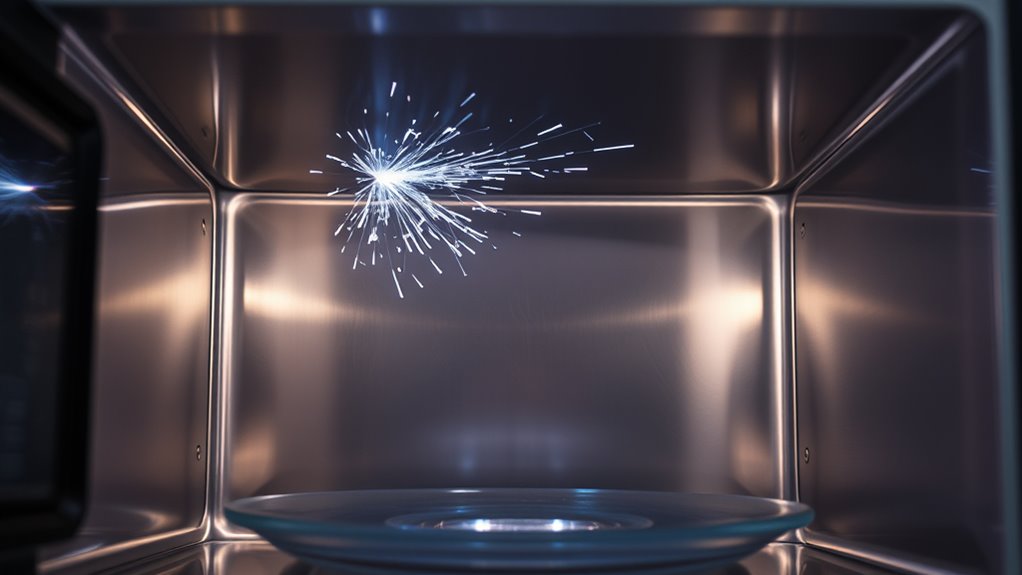Microwave sparks usually happen because metal objects or foil are inside the oven, reflecting microwaves and causing arcs. Sometimes, sparks are just a simple result of food debris or tiny metal particles that have collected. Myths suggest sparks signal serious issues, but often, they’re just preventable hazards. If sparks happen frequently or intensely, it could mean a problem. Keep things safe by removing metal and cleaning regularly—discover more tips on avoiding sparks and keeping your microwave safe.
Key Takeaways
- Sparks are often caused by metal objects or foil inside the microwave, reflecting microwaves and causing arcs.
- Food debris and spills can contain tiny metal particles that create sparks when heated.
- Not all sparks indicate a malfunction; improper use of metallic or inappropriate containers can cause them.
- Regular cleaning and inspecting door seals help prevent sparks related to debris buildup or damaged parts.
- Using microwave-safe containers and avoiding empty runs reduces the risk of sparks and internal damage.
Causes Behind Microwave Sparks

Sparks in your microwave often happen because of metal objects or defects inside the oven. Metal objects, like utensils or aluminum foil, reflect microwaves, causing sparks that can damage the appliance. Even small pieces of metal can create dangerous arcs. Food debris or spills left on the microwave’s interior can also contribute to sparking. When food residue builds up, it can contain tiny metal particles or reflect microwave energy unevenly, leading to sparks. Always check inside for any metal items or food debris before use. Keeping the microwave clean and removing any metal objects prevents these sparks from occurring. Regular maintenance and understanding microwave safety best practices can further reduce the risk of sparks. Additionally, understanding how home theatre projectors work can help you maintain electronic appliances properly. Properly inspecting the interior for potential hazards and ensuring proper appliance maintenance extends the lifespan of your microwave and keeps it safe to operate. Being aware of microwave emission patterns can also help you identify potential issues early and avoid damage. Recognizing signs of microwave component wear can help prevent sparks caused by internal malfunctions.
Myths About Microwave Sparks

Many people assume that microwave sparks always indicate a serious malfunction or that the appliance is unsafe to use. However, some sparks are caused by simple issues like metal objects or foil interference. Placing metal items inside the microwave can cause sparks because metal reflects microwave energy, creating electrical arcing. Similarly, foil can cause sparks if it’s too close to the walls or if it’s crumpled, leading to uneven sparks. Not all sparks signal danger; sometimes, they happen when small metal trimming or utensils are accidentally left inside. Understanding this myth helps you avoid unnecessary panic. Proper use of microwave-safe materials and awareness of metal interference can prevent sparks and ensure safe operation. Being aware of creative storytelling techniques can also help in understanding how effective communication addresses myths and misconceptions. Recognizing microwave safety tips can further help prevent hazards and prolong the life of your appliance, especially when you understand how wave and wind interactions might influence appliance behavior. Additionally, knowing how microwave emission works can help demystify the causes of sparks and promote safer usage practices.
When Sparks Are a Sign of Trouble

Have you ever noticed sparks that seem more intense or persistent than usual? If so, it’s a sign you should pay close attention. Sparks caused by metal objects inside your microwave are a clear trouble sign. Metal can reflect microwaves, leading to arcing and potential damage to the appliance. Additionally, sparks might indicate food contamination, especially if metal pieces or foil accidentally come into contact with moist or unevenly cooked food. Ignoring these sparks can lead to more serious problems, like damaged interior components or even fire hazards. If sparks persist or happen frequently, it’s best to stop using the microwave immediately. Continuing to operate it under these conditions could worsen the damage or pose safety risks. Always inspect your microwave carefully when sparks appear unexpectedly. Proper microwave safety and maintenance can help prevent these issues, especially by being aware of metal objects that should never be used inside a microwave. Being mindful of microwave interior cleanliness can also reduce the risk of sparks caused by food debris. Regularly checking for microwave damage can help catch issues early before they become hazardous.
How to Prevent Sparks in Your Microwave

To prevent sparks in your microwave, start by removing any metal objects before heating your food. Metal, such as aluminum foil or utensils, can cause arcing and damage your appliance. Regular microwave maintenance helps identify and fix issues like loose door seals or damaged components, reducing the risk of sparks. Keep the interior clean by wiping away food splatters and debris, as buildup can cause uneven heating and sparking. Use microwave-safe containers without metallic embellishments, and avoid overloading the microwave, which can cause uneven energy distribution. Proper maintenance and mindful appliance safety practices ensure your microwave operates efficiently and safely, preventing sparks and prolonging its lifespan. Additionally, understanding Floating on Water concepts related to microwave safety can help you better maintain your appliance and prevent hazards. Regularly inspecting the interior for signs of wear or damage can further prevent sparks, ensuring safe operation. Being aware of airflow around the microwave can improve heat distribution and reduce the risk of sparking, which is linked to the attention to detail required for safe appliance use. Taking these steps helps keep your appliance in good condition and minimizes potential hazards.
Safe Practices for Microwave Use

Ever wondered how to use your microwave safely? Practicing proper microwave safety starts with understanding how to operate your appliance correctly. Always use microwave-safe containers and avoid metal or foil, which can cause sparks. Keep the interior clean to prevent food buildup that could lead to overheating or fires. Regular appliance maintenance, like checking door seals and hinges, ensures the microwave operates safely and efficiently. Never run the microwave empty, as this can damage the magnetron. Cover food to prevent splatters and uneven heating. Avoid overheating liquids, which can cause spills or explosions. Using the correct container materials ensures safe microwave operation and prevents potential hazards. Additionally, integrating smart appliance features can help monitor and maintain your microwave’s performance remotely. Proper microwave safety protocols help prevent accidents and extend your appliance’s lifespan, making sure it remains a reliable part of your kitchen. Being aware of magnetron damage risks can also help you identify potential issues early and prevent costly repairs. Regularly inspecting your microwave’s door seals and hinges can help maintain its safety and functionality. Properly following these safe practices helps minimize risks and extend your microwave’s lifespan, making sure it remains a reliable part of your kitchen.
Frequently Asked Questions
Can Certain Foods Cause Sparking in the Microwave?
Yes, certain foods can cause sparking in your microwave. Foods with metallic or foil components disrupt food compatibility and can create sparks. Additionally, using unsafe utensils like metal or aluminum foil increases the risk of sparking. Always guarantee your food is microwave-safe and use appropriate containers. Avoid metallic wraps or dishes with metal accents, and check for any foil fragments to prevent sparking and protect your microwave’s safety.
Do Microwave Sparks Mean My Appliance Is Broken?
A microwave sparking doesn’t necessarily mean your appliance is broken; it often signals the need for better microwave maintenance or a check on appliance safety. Sparks can occur from metal objects or damage inside the oven, much like cracks in glass hint at underlying faults. Instead of ignoring it, inspect your microwave carefully. Addressing sparks promptly helps prevent bigger issues, ensuring your appliance stays safe and functional for years to come.
Is It Safe to Continue Using My Microwave After Sparks Occur?
If your microwave sparks, you should stop using it immediately to guarantee microwave safety. Continuing to operate it could cause further damage or even a fire. Sparks might indicate a need for appliance maintenance, such as checking for metal inside or damaged components. Always inspect your microwave thoroughly before restarting, and consider having a professional examine it to prevent potential hazards and keep your appliance safe to use.
How Often Should I Have My Microwave Inspected for Safety?
Your microwave is your kitchen superhero, so you should have it inspected at least once a year for proper microwave maintenance. Regular appliance safety checks help prevent hazards like sparks or fires. If you notice sparks or other issues, get it inspected immediately. Staying proactive guarantees your microwave stays safe, reliable, and keeps your home protected from potential electrical mishaps. Don’t wait for disaster—schedule safety inspections regularly!
Do Microwave Sparks Affect the Nutritional Value of My Food?
Microwave sparks don’t impact your food’s nutrition or safety. The sparks are usually caused by metal inside the microwave, not the food itself. As long as you avoid metal, your microwave keeps food safe and preserves its nutritional value. Sparks won’t cause nutrient loss or make your food unsafe to eat. To guarantee ideal food safety, regularly check your microwave for damage and avoid metal objects during cooking.
Conclusion
Understanding why your microwave sparks helps you keep it running smoothly, like a well-choreographed dance. Remember, not every spark spells disaster—some are just quirks, but others signal trouble. By following safe practices and debunking myths, you can prevent sparks and keep your kitchen humming. Think of your microwave as a trusted friend—treat it with care, and it’ll serve you well, shining brightly without any unwanted fireworks.









